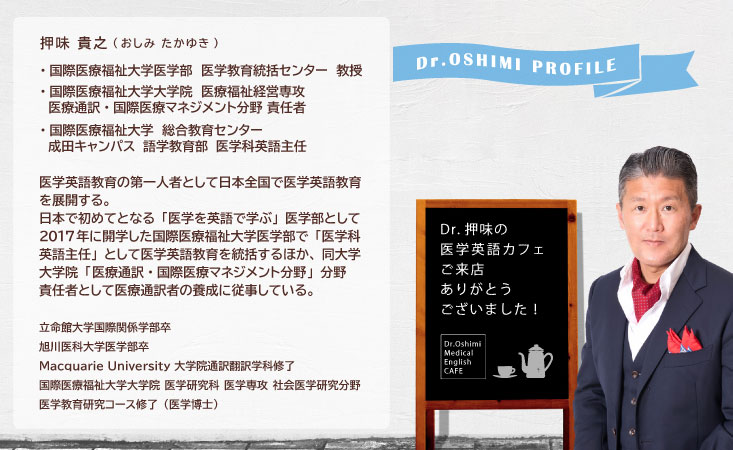
こんにちは。「医学英語カフェ」にようこそ!
ここは「コーヒー1杯分」の時間で、医学英語にまつわる話を気軽に楽しんでいただくコーナーです。
本日のテーマは「腹部膨隆・腫瘤に関する英語表現」です。
お腹が膨らむ「腹部膨隆」とお腹のしこりである「腹部腫瘤」は、「腹部膨隆・腫瘤」として医学教育モデル・コア・カリキュラムにおける「診療の基本」として身につけるべき症状となっています。しかしその鑑別疾患に関する英語表現には日本人には正しく理解されていないものが多く存在します。
また OSCE で必須となっている「腹部診察」を英語で行おうとすると、そこにもよく間違えられる英語表現が数多く存在します。
そこで今月は、「腹部膨隆・腫瘤」の鑑別疾患と「腹部診察」に関する英語をご紹介いたします。
lump, bump, bulge の違いは?
お腹が膨らむ「腹部膨隆」は、英国では abdominal distension と s を使い、米国では abdominal distention と t を使って表現します。ただ abdominal distension/distention という表現は患者さんとの会話ではあまり使われず、“Does your stomach feel bloated?” のように bloated という形容詞がよく使われます。またこの bloated ほど一般的ではありませんが、 “My belly looks swollen.” のように swollen という形容詞が使われる場合もあります。この他にも tightness や pressure のような表現も使われます。また「ベルトの穴を変えて緩める」loosen my belt a few notches という表現も患者さんとの会話では便利です。
お腹のしこりである「腹部腫瘤」の英語表現は abdominal mass です。ただ mass という表現は患者さんとの会話ではあまり使われず、 “Have you noticed any lumps, bumps, or bulges in your abdomen?” のように lump, bump, and bulge のような表現が使われます。
lump とは「(皮膚の下の)しこり」のことであり、表面に現れない腫瘤を示唆する表現です。腹部だけでなく乳腺の「しこり」などにもよく使われる表現です。
bump とは「(外的要因による)小さなコブ」のことであり、頭にできる「たんこぶ」も bump と呼ばれます。動詞の bump には「ぶつかる」という意味がありますので、名詞の bump には「ぶつかってできる腫瘤」というイメージがあるのです。車についている「バンパー」の英語は bumper ですが、これには「車両本体に代わってぶつかってくれる物」というイメージがあるのです。
この lump と bump を使う際には順番も大切です。英語では “Have you noticed any lumps or bump?” のように、必ず lump → bump の順番になります。ですから道路やソファなどが「ゴツゴツしている」という場合に使われる lumpy and dumpy も dumpy and lumpy という語順にはならないのです。
bulge とは「(内側から押されてできる)膨らみ」のことであり、鼠径ヘルニアなど、内側から押されて表面に現れる腫瘤などに使われる表現です。
このように abdominal mass は lump, bump, or bulge のいずれかで表現されることが一般的ですので、この3つをしっかりと区別できるようにしておきましょう。
覚えておきたい「腹部膨隆」の 6 Fs
ではまず、「腹部膨隆」abdominal distension/distention の鑑別疾患を見ていきましょう。
Menu 67 でもご紹介したように、abdominal distension/distention の原因としては 6 Fs という mnemonics「語呂合わせ・暗記法」が便利です。
6 Fs of Abdominal Distension Causes:
- • Fat: Accumulation of abdominal adiposity
- • Fluid: Presence of excess fluid, as in ascites
- • Flatus: Buildup of gas in the intestines
- • Feces: Impaction or accumulation in the intestines
- • Fetus: Pregnancy-related distension
- • Fatal Tumor: Malignant growths that can cause enlargement
Fat「脂肪」に関しては、「内臓脂肪」visceral adipose と「皮下脂肪」subcutaneous adipose という表現を押さえておきましょう。
Fluid「液体」としては「腹水」ascites が重要です。この ascites がある状態では「特発性細菌性腹膜炎」のリスクが高まりますが、この英語は spontaneous bacterial peritonitis (SBP) となります。日本語の「特発性」に引きずられて idiopathic を使わず、「自発性」を意味する spontaneous を使うということに注意してください。
Flatus「ガス」と Feces「大便」が溜まる原因としては「腸閉塞」が重要です。日本では「腸閉塞」のことを「イレウス」と表現することが一般的ですが、英語の ileus は「麻痺性腸閉塞」paralytic bowel obstruction を意味します。「腸閉塞」の英語表現は bowel obstruction となりますので間違えないようにしてくださいね。また flatus とよく似た表現として flatulence というものもあります。flatus は「ガスそのもの」や「オナラをする行為」を意味しますが、flatulence には「ガスの過剰蓄積」や「ガスが溜まることによる不快感」という意味があります。
Fetus「胎児」は妊娠による腹部の膨隆を意味します。そして Fatal Mass「致命的な腫瘤」としては腹部にできる様々な悪性腫瘍を考えます。
このようにかなり大雑把な分類ではありますが、abdominal distension/distention の原因として、この 6 Fs は英語圏では誰もが知っている便利なものですので、しっかりと身につけておきましょう。
「外鼠径ヘルニア」「内鼠径ヘルニア」「嵌頓」「絞扼」の英語表現は?
次に「腹部腫瘤」abdominal mass の鑑別疾患を見ていきましょう。
ここでも上述の 6 Fs が使えるのですが、これに加えて悪性腫瘍ではない mass である「鼠径ヘルニア」inguinal hernia も重要になります。
英語圏の患者さんはこの inguinal hernia という病名を単に hernia と呼んだり、hernia in the groin のように inguinal を使わずに groin を使って表現することが一般的です。
症状としては、英語圏の患者さんは先述した lump や bulge を使って “I have a lump in my groin.” や “There’s a bulge that comes and goes in my groin.” のように表現します。この他にも “Something is popping out in my groin area.” のように popping out「飛び出る」という表現もよく使われます。
日本では鼠径ヘルニアを「下腹壁動脈」inferior epigastric artery の外側の「外鼠径ヘルニア」と、内側の「内鼠径ヘルニア」に分類することが一般的ですが、英語圏ではこれに相当する lateral inguinal hernia と medial inguinal hernia という表現をあまり使いません。
「外鼠径ヘルニア」は「(腹膜)鞘状突起」processus vaginalis という腹膜の遺残が存在する場合に発生します。ここでは内容物が腹壁を直接突き破るのではなく、「鼠径管」inguinal canal を通って腹壁を「間接的」に突き破るので、この鼠径ヘルニアは indirect inguinal hernia と呼ばれます。特に男児に多いのが特徴です。
これに対して「内鼠径ヘルニア」は、腹壁が脆弱な Hesselbach’s triangle を内容物が「直接的」に突き破ることで生じるので、direct inguinal hernia と呼ばれています。heavy lifting, coughing, and constipation などがきっかけになることが特徴です。
このように「外鼠径ヘルニア」は英語では indirect inguinal hernia と、そして「内鼠径ヘルニア」は direct inguinal hernia と呼ばれるのが一般的なのです。
また、突き出たヘルニアが元に戻らなくなった状態を「嵌頓(かんとん)ヘルニア」incarcerated hernia と呼びます。患者さんには “Can you push the lump/bulge back in?” や “Does the lump/bulge stay out even when you lie down?” のような質問をしましょう。
嵌頓ヘルニアが進行して内容物に血流が遮断された状態を「絞扼(こうやく)ヘルニア」strangulated hernia と呼びます。患者さんには “Is the lump/bulge very painful?” や “Is the lump/bulge red, warm, or swollen?” の他、“Do you feel sick or have you vomited?” のような質問をしましょう。
英語で OSCE の「腹部診察」をやってみよう!
最後に、日本の Pre-CC OSCE における「腹部診察」abdominal examination を英語で行う場合の英語表現をご紹介しましょう。
こちらの Geeky Medics というサイトでは、英国の OSCE での項目が詳細に記載されていますが、順序も含めて日本の OSCE とは様々な点で異なっています。
そこでここでは日本の Pre-CC OSCE での腹部診察を英語で行う際に、どのような英語表現を使うのかをご紹介していきましょう。
Introduction: 導入
まずは挨拶・自己紹介です。患者さんの氏名(フルネーム)と生年月日は課題用紙に書かれていますが、それらを患者さんに口頭で述べてもらい確認します。腹痛などの症状の有無もここで確認しておきましょう。そしてそれらが済んだらベッドに仰向けに寝てもらい、腹部を出してもらいましょう。
- • “Good morning/afternoon, my name is [Your Name]. I am one of the medical students at this hospital. I would like to perform an abdominal examination today. Would that be all right with you?”
- • “May I confirm your full name and date of birth?”
- • “Do you have any pain or discomfort in your abdomen?”
- • “Please lie on your back on the bed and expose your abdomen.”
Inspection: 視診
視診では患者さんに次のように述べます。
“First, I’ll take a close look at your abdomen. Please try to relax and breathe normally.”
そして試験官に視診の所見を述べていきます。そこでは「腹部の形状」「皮膚」「その他」に分けて、下記の所見の有無を述べていきます。
Abdominal contour: 腹部の形状
- • Asymmetry: 左右非対称
- • Lateral protrusion: 横への張り出し
- • Distension/distention: 膨隆
- • Retraction: 陥凹
- • Mass: 腫瘤
Skin: 皮膚
- • Rash: 皮疹
- • Discoloration: 着色斑
- • Striae: 皮膚線条
Miscellaneous: その他
- • 手術瘢痕: surgical scar
- • 静脈怒張: venous distension/distention
- • 拍動: pulsations
これらが認められなければ試験官に次のように述べましょう。
- • “On inspection, the abdomen shows no asymmetry, lateral protrusion, distension, retraction, or masses.”
- • “The skin is free of rashes, discoloration, or striae.”
- • “No surgical scars, venous distension, or pulsations are noted.”
Auscultation: 聴診
聴診では peristalsis「蠕動運動」による bowel sounds「腸蠕動音」と、bruits「血管雑音」の有無を聴取します。患者さんには下記のように伝えましょう。
- • “I’m going to listen to your abdomen.”
- • “Please let me know if the stethoscope feels too cold.”
Percussion: 打診
打診では腹部9領域で「鼓音」resonant sounds の有無を確認する他、「肝臓の大きさ」と「脾腫の有無」を確認する必要があります。
- • “I’m going to tap on your abdomen now to check for any fluid or gas in your abdomen.”
- • “Please let me know if my hands feel too cold.”
- • “Please let me know if you feel any pain or discomfort.”
- • “I will now tap to check the size of your liver.”
- • “Please stay relaxed and breathe normally.”
- • “I will tap to check your spleen now.”
- • “Let me know if anything feels uncomfortable.”
Palpation: 触診
触診では、まず 1 cm 未満の「浅い触診」light palpation にて「圧痛」tenderness、「筋性防御」guarding、そして「大きな腫瘤」large mass の有無を確認します。ここでは利き手の4本の指を揃え、tenderness, guarding, or large masses がないかどうかを探るように触っていきます。
- • “I’m going to press gently on your abdomen.”
- • “Please let me know if you feel any pain or discomfort.”
次に 1 cm 以上の「深い触診」deep palpation にて「小さな腫瘤」small mass の有無を確認します。ここでは利き手の4本の指を揃えてそれらを sensor として使い、利き手の反対の手を motor として使います。押す際には探らず、手を引いてくる際に small masses の有無を探りましょう。
- • “I will press a little deeper now.”
- • “Please relax your stomach muscles as much as possible.”
- • “Please let me know if you feel any pain or discomfort.”
そして「肝臓の触診」liver palpation と「脾臓の触診」spleen palpation では、下記のような表現を使います。
- • “I’m going to check your liver by pressing gently under your right rib cage.”
- • “Please take a deep breath in and then breathe out slowly.”
- • “I’m going to check your spleen by pressing gently under your left rib cage.”
- • “Please take a deep breath in and hold it for a moment.”
そして、打診や触診の際には monitor the patient’s face for signs of discomfort ということも忘れないでくださいね。
さて、そろそろカップのコーヒーも残りわずかです。最後にもう一度、「腹部膨隆」abdominal distension/distention の 6 Fs を確認しておきましょう。
6 Fs of Abdominal Distension Causes:
- • Fat: Accumulation of abdominal adiposity
- • Fluid: Presence of excess fluid, as in ascites
- • Flatus: Buildup of gas in the intestines
- • Feces: Impaction or accumulation in the intestines
- • Fetus: Pregnancy-related distension
- • Fatal Tumor: Malignant growths that can cause enlargement
では、またのご来店をお待ちしております。
「Dr. 押味の医学英語カフェ」では、読者の皆さまがこの連載で取り上げてほしい医学英語のトピックを募集しています。こちらのリンクよりお送りください。
国際医療福祉大学医学部 医学教育統括センター 教授
押味 貴之










